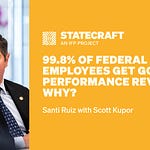Happy New Year! I went on the American Compass podcast last month to talk to American Compass chief economist Oren Cass about government efficiency, state capacity, and what Trump’s Department of Government Efficiency (DOGE) is likely to tackle.
We discuss:
Why is it so hard to fire federal employees?
Off-the-wall ways to save government money
The West Coast meets East Coast dynamic in DOGE
The secret to a successful blue ribbon commission
Notes: This interview was recorded on December 2nd and originally published here. In the audio, I used the phrase “fired for cause,” when I should have said “fired for performance.” The transcript has been corrected.
Hello, my name is Oren Cass. I'm the chief economist at American Compass. Today we are talking about DOGE, the Department of Government Efficiency, with Santi Ruiz, who is senior editor and author of the Statecraft newsletter at the Institute for Progress. He wrote a fantastic piece recently for the Free Press, "The Five Things President Trump Should Do on Day One," and in his work at Statecraft has done a great job identifying what's real and what's vaporware in these discussions about opportunities for cutting red tape, making government more efficient, reducing headcount, and cutting spending.
Some of it might actually happen, some of it could be really positive, and some of it looks less promising, and we will dive into all of that.
You had a fantastic piece really diving into how a Trump administration should approach some of these questions. What do you see as the top one or top three most important points of focus for getting this kind of thing done?
Santi Ruiz: Sure. I flagged the top five in this piece; one of them is hiring and firing. Elon and Vivek have talked quite a bit about clearing out a bunch of employees right off the bat. Earlier in 2024, Vivek suggested firing all employees with odd-numbered Social Security numbers.
I think there's a deeper question that I'm sure they're thinking about: not just how do you reduce headcount right now, but how do you fix the hiring and firing process in general? The federal government fires people at a rate four times lower than the private sector for a variety of procedural reasons. Federal bureaucrats can all appeal their own firings internally. There's no "for performance" requirement. You have powerful public sector unions, and a variety of rules about who has to be fired first when you're doing reductions in headcount. Certain kinds of employees are protected if you're doing large-scale cuts.
It's also really hard to hire good talent. In this piece, I talk about a vignette that Jen Pahlka flagged about a kid named Jack Cable who was 17 when he won the Department of Defense's "Hack the Air Force" contest. He beat 600 other applicants. He found all these weaknesses in Pentagon software. He was excited and decided to apply for a Pentagon job, but the HR manager did not recognize the coding languages he listed, so his resume was graded "not minimally qualified," and he was told to take a hike. They told him that if he spent a couple of years at Best Buy and put that on his resume, it would help him get the job later.
So there's a two-sided problem that you can't just fix by firing a bunch of folks off the bat. You need to find ways to make it easier to hire good talent to bring them in the first place, and to be able to fire the bad folks consistently ten years from now.
It strikes me that there are a few different issues. There's the question of whether you can fire bad people, which is very different from whether you can hire good people. Obviously we want the government to run efficiently and effectively. But firing is also sometimes pitched as a key source of savings, right? “We're going to save so much if we got rid of 50% of the workers.”
One of my concerns is that if you save hundreds of millions of dollars, that makes a big difference if you're running Twitter. If you're talking about the federal budget deficit, it's barely another day's interest payment. Which of those ends are really in focus here? Is it getting the best people doing the job? Is it efficiency? Is it savings? What's actually practical to be going after?
Yeah, Elon and Vivek have flagged three things that they're interested in. They wrote a Wall Street Journal op-ed where they flagged cutting regulation, reducing costs to the taxpayer, and I believe the last one was something like administrative efficiency or effectiveness.
They acknowledge in that piece that the things they're looking at are not going to make a massive dent in the federal deficit. As your listeners probably know, defense spending, Social Security, Medicare, and Medicaid constitute the bulk of federal spending.
They acknowledge that, and I think there are certainly savings that you can find in many places that I expect them to be looking. At IFP, my home think tank, one thing we're interested in is state capacity more broadly. There's a whole bunch of problems with the way the federal government does the things it tries to do right now.
The hiring and firing issue is a classic version of this long-term state capacity problem. Maybe you can save some hundred million dollars here and there by reducing headcount, but if you want to make the thing work better long term, you need to be able to do that consistently. You need to be able to not just cut 20%, but hire and fire for the long haul. That might mean increasing pay for certain roles, which is a big problem, especially in technical areas, where Silicon Valley pays five times what D.C. can pay. Maybe you can't match the private sector, but you can reduce that gap a little bit.
In the research we do at American Compass, we find that everyone complains about the federal government and says they want smaller government. If you ask people which of the things that the federal government does they actually don't want it to do, there's almost nothing. The actual functions that the government provides are essentially all overwhelmingly popular, which helps to explain why we have them all.
I think there is both a recognition that a lot of federal work does get done very poorly and inefficiently and a real desire for change there, but that’s very different from cutting. Cutting can make things worse, not better, if you do it with an eye toward just saving money.
I want to spend some time diving into each of the different elements you've laid out. You've got the hiring, you've got the firing, you've got the more long-term process improvement. On hiring, is higher pay feasible? Where should we actually be aiming if we wanted to be hiring better talent?
So, on pay — Congress can change the fundamental pay scales. Obviously, it's a hard political sell to go to constituents and say “We should pay federal employees more money,” even if it's a smart thing to do.
But there are a lot of tools that the executive branch does have to tinker on the margins here. The Intergovernmental Personnel Act (IPA) is a way to get academic talent on short-term rotations, one to two years. The Biden administration has used it quite a bit. You end-run the normal pay scale and bring these people in on short timelines.
Outside entities can pay their salary. So you could have an academic on loan from their parent institution, doing interesting work at the federal level. There's also work that's been done recently under something called SMEQA — don't ask me to spell out the acronym, we can link it in the show notes [Subject Matter Expert Qualification Assessments]— where basically agencies can do batched hiring for technical positions. Instead of putting out one role at a time, you can say, "Look, we need programmers, we need a bunch of them, they all need to meet certain qualifications, but we need to hire 50 of them." Things like that, which shouldn't seem like incredible innovations, actually are at the federal level. So more aggressive use of those sorts of things would be valuable.
[An editor’s note, courtesy of our friend Jen Pahlka: “SMEQA technically only addresses the lack of assessments. Pooled hiring is a separate process (which is part of the problem.) And the procedures currently required to use assessments, through SMEQA or other pathways, are so onerous that they're only really worth it if you do it for a lot of candidates at once, so the two need to go together. But I'm hoping that the new head of OPM can blow up the 318-page manual that governs use of assessments, get rid of most of those bottlenecks, and make this much better.”]
It also might be possible to convince Congress to bail out certain agencies, even if you can't change the overall pay scale. You could say, "Look, the Department of Energy needs technical talent, and right now we can't get it because you're paying a quarter of what the private sector pays. Can we do a separate pay scale for technical talent?" That's something that exists already in some places, where the federal government acknowledges that even though we can't increase bureaucrat pay across the board, everybody knows that the elite computer programmers need a little bit more of an incentive.
It's not exactly a log-rolling exercise, but if we are actually reducing headcount, there hypothetically is a world in which you could simultaneously be boosting pay and reducing cost, which presumably would be a little bit more palatable on the legislative side.
I remember I was on C-SPAN's Washington Journal recently, where you get a wide variety of interesting questions from the viewing public. We were talking about the deficit, and someone called in to ask if we could cut congressional pay as a way to tackle the deficit.
I was walking through the problem, both that it's 500 people getting paid a couple hundred thousand dollars a year — you can do the math there — but more importantly, that at this point we are paying our congressmen less than somebody can get in their first year as a law firm associate. Thinking that we're going to end up with a more effective government by cutting that further is probably quite backward.
But it is awfully difficult to make the contrary case, especially in an environment where people do feel like the government is so ineffective. You have a bootstrapping problem: no one wants to pay more for what we have now, and we're not going to have anything different unless we pay more. But I do wonder if you could pair having fewer people with maybe paying them more.
That is something that I also dream about. With DOGE especially and the general tech realignment, you do see a lot of people who would not have thought twice about a federal role in the past now thinking, “Maybe there's a role for me to play here.” I think the good government reformers I know all acknowledge, “Look, we're never going to get parity with the private sector on certain kinds of roles.” That's not the point — it's a fool's errand. But what you can do is just make the number a little less of an insult to somebody who would see something five times that number in the private sector. There are plenty of civic-minded folks who need a little bit more of a nudge to get in the door.
But maybe you can reduce headcount quite a bit and then distribute the savings. Connor O'Brien at EIG had this interesting idea of sourcing savings ideas from agency staff and then cutting them in, giving them a small share of the savings generated that way. The idea being that you're never going to find all of the waste, fraud, and abuse looking at it from the top. And you actually need good ideas from the bottom. And to do that, you need to incentivize the production of those good ideas.
There’s a wild ratio between the amount of funding that these folks send out the door compared to the amount that they are themselves being paid. In other words, the typical bureaucrat in an agency may be paid $70,000 a year, and may in effect be signing off on hundreds of millions of dollars going out the door. If you could get rid of the element that doesn't need to be going out the door, the extra $20,000 to the employee is a rounding error in what a more effective job would amount to.
I think that's right. My colleague Caleb Watney had this idea that if the Bureau of Industry and Security (BIS) at Commerce, which is responsible for export control work, seized and kept the proceeds from one shipment of illegally shipped semiconductor chips, I think it would self-fund - it would double the funds dedicated to BIS that year.
That's a really interesting point.
Okay, on the firing side, what do you think is actually plausible? Putting aside how to do it well, just: what will the actual scope of authority and potential action be in a single administration?
I have a lot of uncertainty here and I won't pretend to be confident. Vivek in particular has talked about ways, on the margins, to basically encourage the equivalent of self-deportation for federal employees. Mandating employees come back into the office five days a week, and then saying, "Look, if you don't want to, there's a door," or creating other onerous checkpoints or removal of perks that employees have gotten used to over the past few years.
Although that seems like a good way to lose all of the best employees first.
Yes. If you're just going for reducing headcount, period, the people who are probably the most desperate to hang on are the people who will have fewer opportunities in the private sector. Just to put it bluntly, unless you're firing for performance and you're finding ways to fire for performance, which is difficult in the federal government - there's the equivalent of performance improvement plans that you require to put people on every step of the way — you're going to lose a lot of the people you would really like to keep, a lot of the smart people.
There's also a federal regulation which, again, Jen Pahlka flagged — Title V, Part 351 of the Code of Federal Regulations means that if you're doing reductions in force across the board, you have to start with employees who are serving in specific temporary positions or those under specific special authorities, before you get to the career employees who have been there for 20 years.
And so what that means is people who you've brought in, technical talent on special kind of outside authorities —
Everybody you talked about a few minutes ago as the examples of best hiring.
Exactly. And the people who you imagine Elon and Vivek would be most excited to work with — you have to start by taking a pound of flesh there before you move on. So there's a bunch of regulatory questions.
I do think it's a good sign that the House is forming a parallel committee. If you can get some of the recommendations from DOGE straight into a House bill, then at least you get a better chance at incorporating some of those into law.
One of the problems with blue ribbon commissions or advisory committees is you don't have the political power, the clout afterwards to make the recommendations stick. You would think Elon does, potentially, so maybe that's one of the ways that stuff actually gets into legislation.
I'm curious about the political economy there, though. Obviously, you have fairly powerful public sector unions and lobbies that are resisting that sort of change. On the flip side, it does seem to me you have an awful lot of political momentum, both in a Republican Party that is hoping to carry forward some of Donald Trump's priorities here and, frankly, in a Democratic party that is quite desperate to find savings and perhaps even improvements in government performance that don't require cutting programs. How does that come out in the wash?
This looks like the kind of place where the case for action would potentially swamp the concentrated resistance to it. But obviously for a hundred years that has not actually been the case. What's going on there?
Yeah. Folks who spend a lot of time on this in Washington say there's been lots of improvement on the margins in various ways. Congress functions better than it did 10 years ago, for instance. So you see these little tweaks where, especially when it's not a highly publicized issue, there's lots of room for bipartisanship.
Senator Sanders came out and said that he's fully on board with the DOGE effort to cut waste at the Pentagon. Everybody has their pet peeve. And it's true, there's incredible waste at the Pentagon. It just failed its seventh audit in a row. But I would be surprised to see genuine large-scale bipartisan consensus on this, just because the headcount piece is going to be aggressive, because the regulatory rescissions are very much a Republican interest and not a Democratic one.
And I also think there's a political economy problem: the parts of this that are easiest to message to the public are not the improving state capacity parts. We've seen a lot of the Rand Paul-style tweeting from Elon about bad or silly experiments that science agencies fund — the shrimp running on treadmills stuff — the $500,000 we spent on this or that.
And I think those are easily the easiest part of the DOGE project to sell to the public: "Look at this science experiment we've described a little cruelly." You can get a lot of people on board with cutting that. I think there's a paradox here, where the parts that are easiest to message are the least meaningful fixes or maybe even moving you in the wrong direction.
Yeah. And so then on the flip side, DOGE at the end of the day has no formal power of any sort. It is not technically even part of the government. How do you anticipate that playing out? Do you feel like there's actually a path forward where operating from the outside can still have the sort of influence it wants? Or is it the sort of thing that is likely to be a Silicon Valley innovation that is about to run into the reality of how Washington operates?
I don't think it's naive or silly. We had a guest recently on Statecraft, Dr. Arun Seraphin, who was on another blue ribbon commission, this one to fix the process by which the Pentagon and Congress hash out the defense budget. And Arun flagged for me that basically the problem with blue ribbon commissions is anybody can make the recommendations, but will the people on the commission go push those recommendations later? Do they have the stature to be effective? And do you have a political moment where those pushes could succeed?
I think you have all those in this case. Elon and Vivek are clearly very much bought in on this project and it's been backed by the president. There's a clear kind of political mandate. There's political cover here in a way that plenty of blue ribbon commissions never get. And there's a megaphone here, right? The two co-heads can go directly to the public in a way that plenty of experts and PhDs on blue ribbon commissions can't or don't.
So I think there's a lot of room. I don't think the room is limitless, but I don't think it's the West Coast coming in and thinking it can easily fix the way the East Coast works. I think there's a little bit more going on here than that. That doesn't mean it'll succeed, but I think it's not a fool's errand.
Yeah. I can envision a world in which DOGE, in pursuit of what it sees as the big successful effort, has ideas that are not actually in line with what a White House would be interested in advancing at all. Are they worried about that, or should they be worried about that, or do you feel like there's more alignment there on what is in versus out of bounds?
I would not be surprised — and again, this is speculation — but I would not be surprised if, of the three things that DOGE has said they want to tackle, the regulatory rescissions that are handed off directly to President Trump, recommendations for regulations that can be struck, there's no problem there, and the question is just a legal one about which regulations you can change and how.
I'm guessing that roughly the same will be true for the administrative reductions, the headcount stuff, can you force people to come back into the office. I'm guessing those parts of the puzzle will likely be pretty aligned with the administration's agenda. And then the cost-saving recommendations, I think you're right. It may be that the recommendations are just completely politically dead on arrival, and those are the parts that have to get pushed under the rug, because it's hard to squeeze two trillion out of the federal budget without doing things people don't like. Or maybe there's a world in which we actually take some of that on, but we will have to wait and see.
It’s certainly a bigger political lift than hammering the bureaucrats.















